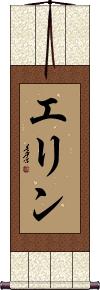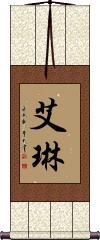Many custom options...
And formats...

Erin in Chinese / Japanese...
Buy an Erin calligraphy wall scroll here!
Personalize your custom “Erin” project by clicking the button next to your favorite “Erin” title below...
Erin
Erin
Erin
Not the results for erin that you were looking for?
Below are some entries from our dictionary that may match your erin search...
| Characters If shown, 2nd row is Simp. Chinese |
Pronunciation Romanization |
Simple Dictionary Definition |
エリン see styles |
erin エリン |
More info & calligraphy: Erin |
ヱ凛 see styles |
erin えりん |
(female given name) Erin; Werin |
依鈴 see styles |
erin えりん |
(female given name) Erin |
叡凜 see styles |
eirin / erin えいりん |
(female given name) Eirin |
営林 see styles |
eirin / erin えいりん |
forest management |
恵琳 see styles |
erin えりん |
(female given name) Erin |
惠輪 惠轮 see styles |
huì lún hui4 lun2 hui lun Erin |
Hyeryun |
愛凛 see styles |
erin えりん |
(female given name) Erin |
慧林 see styles |
erin えりん |
(female given name) Erin |
慧琳 see styles |
huì lín hui4 lin2 hui lin erin えりん |
(female given name) Erin Huilin, a disciple of the Indian monk Amogha 不空; he made the 慧琳音義 dictionary of sounds and meanings of Buddhist words and phrases, based upon the works of 玄應 Xuanying, 慧苑 Huiyuan, 窺基 Kueji, and 雲公 Yungong, in 100 juan, beginning the work in A. D. 788 and ending it in 810. He is also called 大藏音義; died 820. |
慧輪 see styles |
erin えりん |
(female given name) Erin |
慧麟 see styles |
erin えりん |
(female given name) Erin |
映倫 see styles |
eirin / erin えいりん |
(abbr. of 映画倫理機構) Eirin; Film Classification and Rating Organization |
栄凜 see styles |
erin えりん |
(female given name) Erin |
永琳 see styles |
eirin / erin えいりん |
(female given name) Eirin |
江倫 see styles |
erin えりん |
(female given name) Erin |
笑凛 see styles |
erin えりん |
(female given name) Erin |
笑鈴 see styles |
erin えりん |
(female given name) Erin |
絵凛 see styles |
erin えりん |
(female given name) Erin |
絵林 see styles |
erin えりん |
(female given name) Erin |
英鈴 see styles |
eirin / erin えいりん |
(personal name) Eirin |
衣鈴 see styles |
erin えりん |
(female given name) Erin |
イェリン see styles |
erin イェリン |
(personal name) Yellin |
慧琳音義 慧琳音义 see styles |
huì lín yīn yì hui4 lin2 yin1 yi4 hui lin yin i Erin ongi |
Huilin's Sounds and Meanings |
エイリーン see styles |
eiriin / erin エイリーン |
(personal name) Alene |
慧琳一切經音義 慧琳一切经音义 see styles |
huì lín yī qiè jīng yīn yì hui4 lin2 yi1 qie4 jing1 yin1 yi4 hui lin i ch`ieh ching yin i hui lin i chieh ching yin i Erin issai kyō on gi |
Huilin's Sounds and Meanings [of all the words in] the Scriptures |
The following table may be helpful for those studying Chinese or Japanese...
| Title | Characters | Romaji (Romanized Japanese) | Various forms of Romanized Chinese | |
| Erin | エリン | erin | ||
| Erin | 艾琳 | ài lín / ai4 lin2 / ai lin / ailin | ||
| Erin | 愛琳 爱琳 | ài lín / ai4 lin2 / ai lin / ailin | ||
| In some entries above you will see that characters have different versions above and below a line. In these cases, the characters above the line are Traditional Chinese, while the ones below are Simplified Chinese. | ||||
Successful Chinese Character and Japanese Kanji calligraphy searches within the last few hours...






